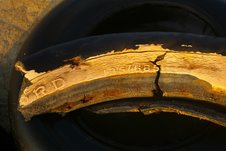Story by John Vonderlin (email John: [email protected])
Hi June,
As you know I’m collecting tires as part of my “101 Tires” artplay. Along with complete ones that I count as part of my project, before disposing of them, I also gather tire parts. I used to throw those away, until mid-December when I found this remnant at Pescadero Beach.
It was strange-sized, with non-significant to me numbers, and a few embossed letters that hinted at Ford. I did a websearch on the numbers, vintage Ford tires, tractor tires, etc. and found nothing. I held onto the remnant as a curiosity, and a mystery, thinking someday I’d find somebody who knew what it was.
Well, a few days ago, before this giant storm came to whack us, I figured I better make a quick beach survey. Once again at Pescadero Beach, I found another remnant. This time with lots more info on it. 135/685…The Star Rubber Company…Akron O…RD…CSAA. I was also able to approximately measure the inner circumference of the tire and its width, 30 inches and 4 inches respectively.
It wasn’t easy finding info on it and I’m not 100% sure, but I believe this is an original Model T tire, 80 years or more old.
Here’s a Wikipedia excerpt from the Model T page:
The standard Model T Tire size was 30″ X 3″ for front tires, and 30″ X 3 1/2″ for rears. Demountable Wheels, which were offered as an option starting in 1919, were 30″ X 3 1/2″ for all four wheels. In 1925, 21″ demountable Balloon tires/wheels were offered as an option and in 1926, 21″ wire wheels were introduced (as an option) which used the same tires. In 1927, 21″ tires and wheels were used on all cars.
The fact that the make of auto it was intended for, that is “Ford,” was embossed on it, tells me that it was from a time when there were very few car makers, with even less interchangeability of parts.
The “Star Rubber Company,” was also difficult to locate any info on, but in a book about Akron, Ohio, from 1875-1925 by Mr. Busbey, I found this excerpt:
One of the earlier rubber companies was the Star Rubber Company, founded in 1907 by S. E. Duff, its first president; Homer A. Hine, its first secretary, and J. W. Miller, the first treasurer. L. H. Firey became president in 1916 when the company launched actively in the tire manufacturing business, having previously made druggists’ rubber sundries. Present officers are L. H. Firey, president; R. L. Robinson, vice president, and D. A. Grubb, vice president and sales manager; J. W. Dessecker, secretary, and R. G. Shirk, treasurer. The company now is capitalized at more than $1,000,000 and has capacity for 750 tubes and 600 tires a day.
Researching other tire companies in Akron, the onetime “Tire Capital of the World,” I found this nugget:
In 1962, Kelly-Springfield acquired the Star Rubber Company (a company that originally devised the first radial tires), along with three other corporations connected to Star: the Hick’s Rubber Company, Richmond Rubber Company, and Richmond Tire & Rubber Company. At the time of their acquisition, Star and the Richmond companies had long ceased manufacturing tires, preferring to distribute tires and inner tubes wholesale. In 1975, these subsidiaries merged as divisions within Kelly-Springfield.
Finally, on ebay I found this 1916 poster of the “Star Rubber Company” for sale. It offers distributorships for their tires. I wonder how many people got in on this at ground floor and founded dynasties that we would recognize today?
I also wonder where this tire was before I found it? There were no barnacles or other sea growth on it. Was it buried in the sand all these years, only to be uncovered by the giant waves of mid-December? Is there a car out there? If so, what else will wash ashore? Whatever the answer, to me, it has already been a case of one man’s trash being another man’s treasure. I’m thinking of joining one of the Model T forums (there are 250,000+ restored Model T’s out there) and trying to find answers to at least some of the questions I have. Enjoy. John
P.S. The letters, CSAA, which are incised, as opposed to all the other embossed information on the tire, almost surely represents the California State Automobile Association. It may have been the way they ensured they were only serving their customers, which given the frequency of flat tires a hundred years ago wasn’t a bad idea.
Here’s an interesting excerpt from Wikipedia about the C.S.A.A.:
The California State Automobile Association is a motor club dedicated to improving roads, proposing traffic laws and improvement of overall driving conditions. It was founded in 1907 as an offshoot of the Automobile Club of Southern California (ACSC) to serve members in Northern California. Today, as an affiliate of the American Automobile Association (AAA), it also provides services to those in Nevada and Utah.
Just like the Auto Club, the CSAA sent teams of cartographers to survey California’s roads for the production of maps. The CSAA also helped post thousands of porcelain-on-steel traffic signs throughout the state and continued to do so until the State of California took over the task in the early 1950s.


